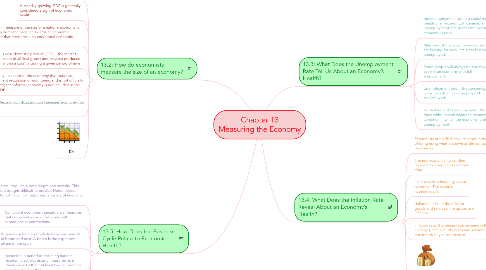Chapter 13 Measuring the Economy
by Chloe Decker

1. 13.5: How Does the Business Cycle Relate to Economic Health?
1.1. Business cycles are irregular in both length and severity. This makes peaks and troughs difficult to predict. Nonetheless, economists attempt to do just that, using a variety of economic indicators.
1.2. Coincident economic indicators are measures that consistently rise or fall along with expansions or contractions.
1.3. Business cycles are popularly known as periods of boom and bust. A boom is the expansion phase of the cycle.
1.4. recession: a period of declining national economic activity, usually measured as a decrease in GDP for at least two consecutive quarters (six months)
1.5. depression: a prolonged economic downturn characterized by plunging real GDP and extremely high unemployment
2. 13.2: How do economists measure the size of an economy?
2.1. Economists use GDP figures to determine not only how big an economy is, but whether it is growing or shrinking and at what rate.
2.2. A steadily growing GDP is generally considered a sign of economic health.
2.3. The main measure of the size of a nation’s economy is its gross domestic product. GDP is an economic indicator that measures a country’s total economic output.
2.4. Gross domestic product (GDP) - the market value of all final goods and services produced within a country during a given period of time
2.5. Informal Economy - a sector of the economy that operates without government regulation or monitoring and is not officially recorded or taxed; the informal economy is not included in the calculation of GDP
2.6. http://economics.about.com/od/economicindicatorintro/a/measure_economy.htm The website answers the question perfectly.
2.7. ....
3. 13.3: What Does the Unemployment Rate Tell Us About an Economy’s Health?
3.1. the unemployment rate is a useful indicator of the health of an economy. In general, a high unemployment rate means the overall health of the economy is poor.
3.2. Members of the labor force who are jobless, but are looking for work, are classified as unemployed.
3.3. Some people will always be out of work, even in an economy with full employment.
3.4. Unemployment rate - the percentage of the labor force that is not employed but is actively seeking work
3.5. Natural Rate of Unemployment - the percentage of the labor force without work when the economy is at full employment; a condition in which the economy is strong and there is no cyclical unemployment
4. 13.4: What Does the Inflation Rate Reveal About an Economy’s Health?
4.1. Economists at the BLS track changes in the cost of living using what is known as the consumer price index.
4.2. The real cost of living can then be used to compare prices over time.
4.3. Occasionally inflation goes into overdrive. The result is hyperinflation.
4.4. deflation: a fall in the price of goods and services; the opposite of inflation
4.5. inflation rate: the percentage increase in the average price level of goods and services from one month or year to the next
4.6. ..


